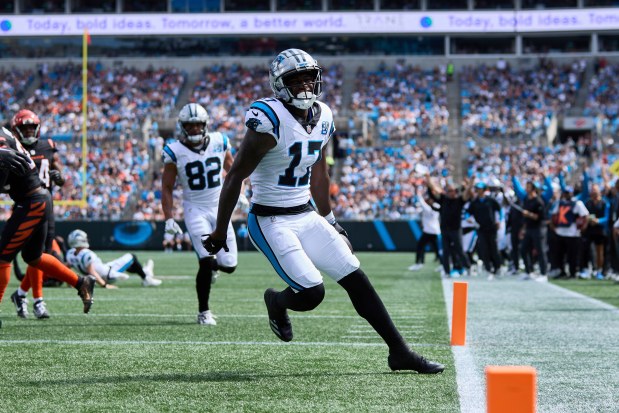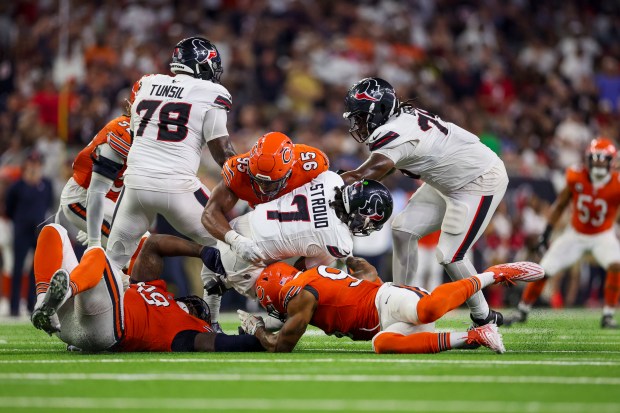Travis Smith was sitting at his desk on the day the Chicago Bears opened the voluntary offseason program when Gervon Dexter Sr. filled the doorway to his office.
At 6-foot-6 and with a reworked physique, Dexter really filled the doorway.
“Whoa,” Smith, the defensive line coach, recalled thinking. “OK.”
The Bears didn’t have a long to-do list for Dexter during his exit interview after his rookie season, but one thing they recommended was that he dedicate himself to making the most of his athletic ability.
Dexter returned at about 309 pounds, the weight he says he’s at now, and while that’s down only 10 from 2023, he looks completely different. He didn’t just lose weight, he redistributed it in his frame, adding lean muscle.
Work and dedication the team raved about over the offseason is paying dividends. Dexter enters Week 5 with three sacks, tied for second in the league among interior linemen with four others behind Kevin Givens, who has 3½ for the San Francisco 49ers.
The pass rush — which was almost nonexistent at the start of last season — has been solid, and while defensive end Montez Sweat’s presence keys so much, the Bears are getting the kind of production from the three-technique position that is critical to Matt Eberflus’ scheme.
Dexter, 22, began to figure things out during the second half of last season after looking a little lost in the beginning — he was consistently late off the snap. It was a real adjustment playing in a one-gap scheme after being asked to two-gap at Florida. And in the NFL he couldn’t win with simply size, strength and athletic ability.
Nine of his 12 quarterback hits came in the final eight games, but there was a feeling much of his talent had been untapped. Without a scouting combine to prepare for — as he had done the previous year — Dexter could focus on football-specific training. That meant a new diet, lifting and the addition of flexibility work.
“I had to do it the right way,” Dexter said. “And really for me it was the late eating. I had bad habits of eating late-night snacks and too much sugar. I ate more protein with less carbs — heavy protein and less carbs to lean out.”
When Dexter returned — then in June and July with more work before training camp — he slimmed down, toned up and then turned heads just like he startled Smith when he entered his office.
“If you feel good, you can play good,” Dexter said. “The leaner you are, the faster you can play.”
Dexter was quick off the ball in training camp, but with the defense winning most days and little real contact for linemen, it was difficult to tell how the new-look lineman would fare in game action. Those questions can be answered emphatically after a month.
His nine pass-rush wins are tied for seventh in the league among interior linemen. His pass-rush win rate is 18%, ranked ninth among defensive tackles with 20 or more reps. Dexter’s eight QB pressures are 10th at the position and the same number Jalen Carter has for the Philadelphia Eagles. Carter, of course, is the pick the Eagles made at No. 9 in 2023 after trading up with the Bears.
“He’s got such a greater understanding of the game that he’s playing faster,” fellow tackle Andrew Billings said.
Dexter has a better idea of what to expect from opposing linemen, and that knowledge combined with his physical gifts have to make general manager Ryan Poles and Eberflus believe he’s just beginning to scratch the surface.
Here is snapshot of his three sacks.
.@GervonDexter breaks through for the SACK
: #TENvsCHI on FOX pic.twitter.com/XyHrc3ecpK
— Chicago Bears (@ChicagoBears) September 8, 2024
- Week 1: With middle linebacker Terrell Edmunds walked up to the line of scrimmage to give the Bears a 50 front, the Tennessee Titans slid the protection away from Dexter and Sweat (on the defense’s left), giving them defined one-on-one rushes. They ran a twist-stunt with Dexter as the vertical picker, and he occupied the right guard and right tackle. When guard Dillon Radunz came off to block Sweat, Dexter pushed through for a sack of Will Levis.
Gervon Dexter Sr. gets the sack for the @ChicagoBears!
: #CHIvsHOU on NBC/Peacock
: Stream on #NFLPlus pic.twitter.com/AwvbGoWVS1
— NFL (@NFL) September 16, 2024
- Week 2: In Houston, Dexter picked up his second sack off another stunt, this time with DeMarcus Walker. The Bears were in a wide alignment, and the running backs released because there was no blitz. There was another slide protection away from his side, and Walker occupied the left guard and center, actually grabbing the center without a penalty. That created a runway for Dexter to get to Texans quarterback C.J. Stroud, an athletic quarterback who isn’t easy to bring down.
Welcome to Dexter's Laboratory
: #LARvsCHI on FOX pic.twitter.com/iGGuVifPjN
— Chicago Bears (@ChicagoBears) September 29, 2024
- Week 4: Darrell Taylor and Dexter had one-on-one rushes, and Dexter used an arm-over move from the three-technique position to accelerate past right guard Kevin Dotson and sack Matthew Stafford.
Dexter nearly had another sack in the Week 3 loss in Indianapolis when he used a club and arm-over to beat Colts right guard Will Fries. Against a quarterback not as big, strong and as athletic as Anthony Richardson, it probably would have been a sack, but Dexter forced a throw out of bounds that could have been deemed intentional grounding.
“I wouldn’t say the (club and arm-over) is my go-to move right now,” Dexter said. “My go-to is winning my one-on-one. I take what the guard or center is giving me or if I’m out there at the five, what the tackle is giving me. If he’s showing low hands, I may go arm-over. If he’s showing high hands, I’ll swipe and if he’s passive and setting up, I will give him power.
“So far, what a lot of guards have been giving me is aggressive hands, aggressive slides, and that’s when the club or the arm-over works.”
It’s precisely what the Bears want out of a second-round pick in Year 2, a player who is beginning to showcase the athletic talent and growth potential the team identified in the scouting process. Dexter still needs to focus on playing with good pad level — something all tall linemen need to work on constantly — and sharpen his run defense. But he’s pushing the pocket from the interior, which is what the Bears had hoped.
David Turner, who was the defensive line coach at Florida when Dexter enrolled, said he wasn’t much different than Chris Jones, the Kansas City Chiefs star, when Turner coached him at Mississippi State. Turner has connected the two, and Dexter spent time in the offseason studying Jones on film as well as watching the Colts’ DeForest Buckner, another tall (6-7) interior lineman.
“I talked to Chris all the time,” Dexter said. “He is my Michael Jordan of the D-line stuff. He’s consistently a disrupter. That’s what I want to add to my game. You know what you are going to get from Chris Jones every time. If it’s third-and-long and you’re watching on TV, he’s the guy they are putting that little circle around.”
Upcoming opponents are going to begin circling Dexter in their game plans if he continues to produce. He had 2½ sacks last season and set a goal of “eight-plus” in 2024.
“I’m still shooting for that,” he said.
That seems realistic considering Dexter’s start and would be equal to the production from some of the better Bears interior pass rushers in recent decades. Only three of their interior linemen have reached eight sacks in the last 25 years: Akiem Hicks, 8½ in 2017; Israel Idonije, 8 in 2010; and Tommie Harris, 8 in 2007.
“He’s done it the right way,” Smith said of Dexter. “The mentality, his makeup is what you are looking for. It’s only going to keep getting better.”
Scouting report

Xavier Legette, Panthers wide receiver
Information for this report was obtained from NFL scouts.
Xavier Legette, 6-foot-3, 227 pounds, is a rookie the Panthers drafted with the 32nd pick out of South Carolina. He has become a bigger part of the passing game with veteran Adam Thielen (hamstring) on injured reserve.
Thrust into a bigger role last week against the Cincinnati Bengals, Legette had six receptions on 10 targets for 66 yards and a touchdown. He has 12 receptions for 143 yards on the season.
“It’s taken him some time to develop playing behind two veterans — Adam Thielen and Diontae Johnson — and that has to be expedited now,” the scout said. “The passing game wasn’t working with Bryce Young, but last week with Thielen out … his volume spiked and he was productive. He was good as a route runner and he showed the things that made him a first-round pick, even if most clubs probably had him pegged as a two. He got buzz at the Senior Bowl because he’s long (and has a) thick frame but he’s a little tight-hipped. When he comes out of his breaks, he’s got to work extra hard to create separation because he’s not a fluid lateral mover. But in terms of straight-line juice and power, he’s got that, and you’re seeing it now.
“The No. 1 thing about a rookie receiver — and it’s very hard: Can you play through contact? Rookies get jammed and rerouted and they fall off routes and they can’t get to their landmark because they’re being pushed around. He will play through contact and he’s strong in the lower and upper body. He’s slants, screens, veritcals, deep in-breakers and a lot of crossers. You’re not doing everything on the route tree with him, but he can go. I’m not going to compare him to another South Carolina receiver, Deebo Samuel. Everyone wants to do that, but Deebo is much more fluid. Legette is a smaller version of D.K. Metcalf, who is a straight-line power athlete and a guy who is extremely tight-hipped. You get these guys on a north-south track, they are as explosive as they can be, and I think you will see more from this kid with Andy Dalton at quarterback.”





